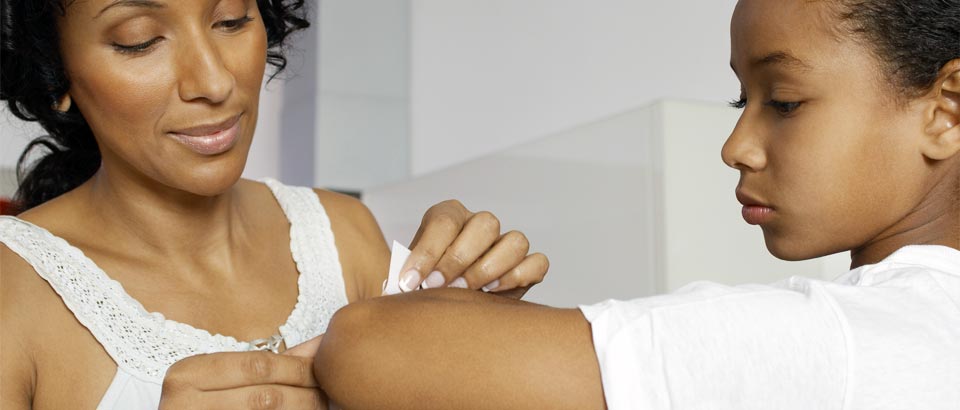The good news is that most warts can be treated by yourself at home. You can get several over-the-counter wart remedies – such as salicylic acid in gel, liquid or pad form – with no prescription needed. If you see no changes in 12 weeks or if the skin around the area becomes red and bleeds, you should seek medical attention instead of using at-home remedies. There’s also the chance that you may mistake another type of skin growth, including some skin cancers, for a wart.1
You should visit your neighborhood MedExpress if you have any of the following symptoms:1
- A wart on your face or genitals
- You have multiple warts
- The warts itch, burn, bleed or cause you pain
- A suspicion that the growth is not a wart
- It won't go away
If you have a weakened immune system or diabetes, you should see a provider for any wart issues and should never remove any warts on your feet. If you cut or burn the skin, it may cause permanent damage to the nerves in your foot.1
Additionally, plantar warts are often difficult to treat with at-home remedies.
There are also several home remedies for wart removal. Instead of these potentially unproven methods, if a wart is causing you discomfort, just visit us to get back to feeling better fast.
Depending on the location, size and condition of the wart, the way that we care for you may be different. Treatment options include:2

Salicylic acid
Salicylic acid solutions can be applied at home as there are several over-the-counter options available without a prescription. Soak the wart in warm water. When dry, use a pumice stone or emery board to gently scrape away the dead skin. Apply the acid and then repeat once or twice a day. Continue treatment until up to two weeks after the wart is gone. If you feel any pain, stop this treatment and consult with your provider or visit MedExpress.
You may also hear the term lactic acid. Several salicylic acid solutions also contain this.
Cryotherapy
This process freezes the wart by applying extremely cold liquid nitrogen to it. This destroys cells in the top layer of your skin by dipping a cotton swab in the liquid nitrogen and pressing it against the wart or by spraying liquid nitrogen onto the wart. This treatment is repeated for several sessions with a week’s break between appointments.
These treatments often are able to heal most warts. However, if your wart requires further treatment, MedExpress can provide a referral to a specialist with more specialized treatments for your unique condition.
wart removal at MedExpress
Need a wart removed? Schedule an appointment online or walk in any time from 8 to 8 every day.
For your convenience, we accept most major insurance, most of which cover wart removal. To verify that your insurance is in-network, visit the Plan Your Visit page. We also offer a discount to those patients who choose to pay in full for their visit at the time of services. Self-pay services are $199.

What is a wart?
Warts are skin growths that most often appear on the hands. They appear when one of the many viruses of the human papillomavirus (HPV) family infects the top layer of your skin, often when you cut or damage your skin.1
Warts grow in the areas where the virus has infected your skin. They’re caused by extra cell growth that your body creates to combat the infection. This cell growth makes the outer layer of your skin thicker and harder. That’s a wart and it will often be the same color as your skin, but can also be dark, brown or dark gray in color. While some warts are rough to the touch, others may be smooth. Warts themselves are benign but you should always have a provider examine warts that are troublesome to determine if you have another skin condition or skin cancer.
What are the symptoms? There are several types of warts and their symptoms are different based on where they appear on your body. It may take a few months for warts to appear.
Common warts3
- Most often found on the back of your hand, your fingers and around your fingernails
- If you or your child pick the nose, these may also appear under the nose
- Can be caused by biting or picking at fingernails
- May have rough bumps
- May have black dots. People have throught that these are seeds in the past, but the truth is that the black dots are blood trapped within the wart.
Foot or plantar warts3
- There are two types:4
- A soliary wart is one that appears on its own but may multiply
- Mosaic warts appear in clusters on the soles of your feet and are more difficult to treat
- Are painful and feel like you have a pebble in your shoe
- May have black dots, which are dried blood from the tiny blood vessels in your foot4
- As they grow larger, they also grow deep into the skin, making them difficult to remove4
Flat warts3
- May appear anywhere on your body
- Kids usually have them on their faces, while men get them in the beard area and women on their legs
- Grow in large numbers - as many as a hundred at a time
- Small and smooth to the touch
Filiform warts5
- Appear around your mouth, eyes and nose
- Look like long threads or thin fingers
- Often grow quickly
Are warts contagious? Yes. They can be spread by making contact with another wart or object that has touched the wart.
How do warts develop? Viruses called human papillomavirus (HPV) are the cause of warts.4 These viruses are easier to catch when you have cuts or scrapes on your skin. That explains why warts often appear in the areas that we shave or why so many children get them, as they often have small cuts or scraps on their skin.
Warts can do more than spread from person to person. They can also be spread from one part of your body to another.
If you have a weakened immune system, your risk of getting a wart is increased.4
What is a plantar wart?5
This type of wart mostly shows up on the bottom, or plantar, side of your foot. It can also appear on the toes or other weight-bearing locations like your heel.
Are warts contagious? Yes. Plantar wars can spread by:6
- Making contact with someone who has a plantar wart
- Walking barefoot in areas around swimming pools and locker rooms
- Sharing socks, shoes and towels with an infected person
While plantar warts may often go away on their own, this can take months and possibly even years. If they are painful and causing you discomfort during your daily activities, you may need treatment to remove them.
Does MedExpress treat other skin growths?
Yes, MedExpress also has treatment for corns and skin tags. For more information on the skin growths and conditions that we treat, visit our page on Skin Condition, Rash & Bug Bite Treatment.
There's no need to be embarrassed by these conditions. At MedExpress, you'll find a friendly and helpful medical team ready to help you get better and looking your best, too.
References:
- American Academy of Dermatology Association. Warts: Self-Care. Accessed November 30, 2023.
- National Library of Medicine/National Center for Biotechnology Information. What are the treatment options for warts? Accessed December 19, 2023.
- American Academy of Dermatology Association. Warts: Signs and Symptoms. Accessed November 30, 2023.
- American Academy of Dermatology Association. Warts: Overview. Accessed November 30, 2023.
- American College of Foot and Ankle Surgeons. Plantar Wart (Verruca Pantaris). Accessed November 30, 2023.
- American Academy of Dermatology Association. Warts: Who Gets and Causes. Accessed November 30, 2023.
